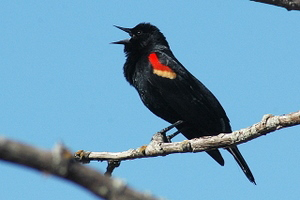Most males have multiple females nesting in their territories. Up to 15 females have been found nesting within the territory of a single male, although the average number is 5 or fewer.
Photo Credit: Geoffrey A. Hammerson
Agelaius phoeniceus
Common Name: red-winged blackbird
Animal Guild: Bird
Class > Order > Family: Aves > Passeriformes > Icteridae
What does the species look like?
Adult males are black with an orange-red and yellowish shoulder patch (colorful patch may be hidden; yellow part may be absent). Adult females are brownish and have a heavily streaked breast, a pale stripe over the eye, and may have reddish tones on the back or shoulders. Juveniles resemble adult females. The bill is straight and tapers to a point. Adults are about 8.75 inches (22 cm) long.
Where is the species found?
States & Provinces
AK, AL, AR, AZ, CA, CO, CT, DE, FL, GA, IA, ID, IL, IN, KS, KY, LA, MA, MD, ME, MI, MN, MO, MS, MT, NC, ND, NE, NH, NJ, NM, NV, NY, OH, OK, OR, PA, RI, SC, SD, TN, TX, UT, VA, VT, WA, WI, WV, WY
Distribution
Breeding range extends from southern Yukon across Canada to Nova Scotia, and south to Baja California, Costa Rica, western Cuba, and the northern Bahamas. This species winters over much of United Sates, especially in the southern part.
Habitat includes freshwater and brackish marshes, bushes and small trees along watercourses, and upland cultivated fields. In migration and winter, this blackbird also occurs in open cultivated lands, plowed fields, pastures, and prairies. Nests usually are near water, in cattails, rushes, or sedges, occasionally in shrubs or trees.
General Phenology and Life History
Red-winged blackbirds withdraw from the northern part of the breeding range for winter, returning usually in February-March. Nesting begins in April-May in most areas, sometimes in late March, and may continue into July. Most clutches include 2-4 eggs. Incubation, by the female, lasts 11-12 days. Nestlings are tended by both parents or, in some areas, by the female only. Young are able to leave the nest in about 10 days. This species nests in loose groups; male territories may include up to several nesting females. Sexes tend to segregate in the nonbreeding season. This species may form huge winter roosts of up to several million birds.
Which phenophases should I observe?
Do you see/hear...?
Activity
Live individuals More...
For abundance, enter the number of individual animals observed in this phenophase.
Feeding For abundance, enter the number of individual animals observed in this phenophase.
Fruit/seed consumption For abundance, enter the number of individual animals observed in this phenophase.
Insect consumption For abundance, enter the number of individual animals observed in this phenophase.
Calls or song For abundance, enter the number of individual animals observed in this phenophase.
Singing individuals For abundance, enter the number of individual animals observed in this phenophase.
Territorial individuals For abundance, enter the number of individual animals observed in this phenophase.
Reproduction
Courtship For abundance, enter the number of individual animals observed in this phenophase.
Mating For abundance, enter the number of individual animals observed in this phenophase.
Nest building For abundance, enter the number of individual animals observed in this phenophase.
Occupied nest For abundance, enter the number of individual animals observed in this phenophase.
Development
Nestlings For abundance, enter the number of individual animals observed in this phenophase.
Fledged young For abundance, enter the number of individual animals observed in this phenophase.
Dead individuals For abundance, enter the number of individual animals observed in this phenophase.
Dead nestlings or fledglings For abundance, enter the number of individual animals observed in this phenophase.
Method
Individuals at a feeding station For abundance, enter the number of individual animals observed in this phenophase.
What do these phenophases look like?
There is currently no photoguide available for this species. If you'd like help us create one, use the guidance document and species template provided here . Then send it via email to education@usanpn.org when it is complete.
